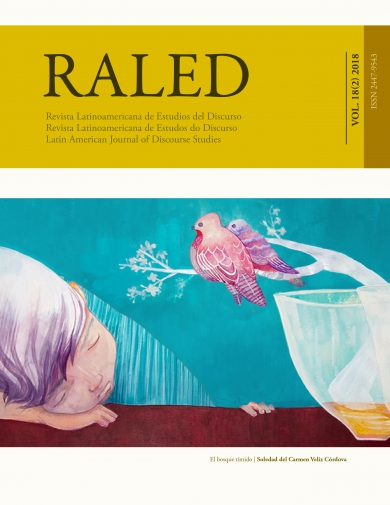Punitive discourse from a critical perspective
reduction of the penal age
Keywords:
discourse. adolescents. socioeducation. reduction of criminal responsibility.Abstract
The objective of this article is to discuss the topic of the reduction of the criminal responsibility in the Brazilian context. To do so, we seek to point out reasons that cross borders of the order of legal discourse, as well as linguistic-discursive relations present in discourses of adolescents in situations of imprisonment so that there is a reflection regarding the implementation of the PEC that reduces the penal age. Such an initiative, instead of favoring justice, could accentuate the social question of poverty, above all, in relation to young people who were born on the margins of society and still survive in a situation of exclusion. For the description and interpretation of documentary data, selected in the last two years (2016-2017), we rely on Critical Discourse Analysis (Fairclough, 2003; 2010), associated with Systemic-Functional Linguistics, proposed by Halliday (1994) and extended in Halliday & Matthiessen (2004; 2010). We completed a theoretical triangulation with the proposal of BHASKAR’s Critical Realism (1998).
Downloads
References
Barros, S. M. 2015. Realismo crítico e emancipação humana. contribuições ontológicas e epistemo-lógicas para os estudos críticos do discurso. Campinas, SP: Pontes Editores. Coleção: Linguagem e Sociedade.v.11.
Bhaskar, R. 1998. Philosophy and scientific realism. Em M. Archer e R. Bhaskar; A. Collier; T. Lawson e A. NorrieA. (eds.). Critical realism: essential readings, pp. 16-47. London/ New York: Routledge.
Carvalho, A. C. C. 2016. Práticas discursivas disciplinadoras voltadas para adolescentes: uma perspec-tiva crítica. 264f. Tese (Doutorado) ”“ Departamento de Linguística, Português e Línguas Clássicas. Universidade de Brasília.
Carvalho, A.C.C. 2011. Reintegração dos presos por meio da educação a distância. Brasília: Editora Ser.
Constituição da República Federativa do Brasil. 1994. Organização de textos e índices. Valdemar P. Da Luz, 2.ed. Porto Alegre: Sagra DC Luzzatto.Declaração Universal dos Direitos Humanos (DUDH). [Disponível na internet em https://nacoesunidas.org/img/2014/09/DUDH].[Consulta: 11de agosto de 2018].
Eggins, S. 1994. An Introduction to Systemic Functional Linguistics. London: Pinter Publishers.
Fairclough, N. 2001. Discurso e Mudança Social. Tradução de Izabel Magalhães. Editora: Univer-sidade de Brasília.
Fairclough, N. 2003. Analysing discourse. London and New York: Routledge.
Fairclough, N. 2010. Critical Discourse Analysis: The Critical Study of Language. 2.ed. London: Longman Applied Linguistics.
Garcia, O.M.2004. Comunicação em prosa moderna: aprenda a escrever, aprendendo apensar, 24. ed. Rio de Janeiro: Editora FGV.
Halliday, M. A. K. 2003. An Introduction to Functional Grammar. London: Edward Arnold, 1994. Halliday, M. A. K. On Language and Linguistics. In the Collected Works of M.A.K. Halliday. Jonathan Webster Continuum (Ed.). New york: Equinox, v.3.
Halliday, M. A. K.1989. Em M.A.K. Halliday e R. Hasan. Language, context and text: aspects of language in social-semiotic perspective. Oxford: Oxford University Press. Ishida, V. K. 2013. Estatuto da criança e do adolescente: doutrina e jurisprudência. 14.ed. São Paulo: Atlas.
Marcuschi, L.A. 2008. Produção textual, análise de gêneros e compreensão. São Paulo: Pará-bola Editorial.
Montecino. L. 2010. “Historias de vida” de personas em situación de calle de Santiago de Chile: Descripción de una práctica discursiva, pp. 245-272. Em L. Montecino (Ed.). Discurso, pobreza y exclusión social em América Latina. Santiago: Editorial Cuarto Propio.
O Globo. 2018. [Disponível na internet em https://oglobo.globo.com/brasil/datafolha-cres-ce-apoio-reducao-de-maioridade-penal-em-crimes-graves-22249123#ixzz5R8mB4ZDl]. Datafolha: cresce o apoio à redução de maioridade penal em crimes graves. [Consulta: 15 de agosto de 2018].
O Globo.2018. [Disponível na internet em https://oglobo.globo.com/brasil/a-cada-8-dias-um-adolescente-infrator-apreendido-morre-no-brasil-22992230]. A cada 8 dias um adolescente infra-tor apreendido morre no Brasil. [Consulta: 11 de agosto de 2018].
Sen, A. 2010. Desenvolvimento como liberdade. Trad: Laura Teixeira Motta. São Paulo: Companhia das Letras.
Silva, D. E. G. 2007. Identidades enfraquecidas versus cidadania cultural. Em J. Sébastien (org.). Diversidade cultural, linguagens e identidades. v. 1, p. 51-68. Recife: Elógica.
Silva, D. E. G. 2013. A gramática da pobreza em práticas discursivas de atores sociais: uma pers-pectiva crítica. Em J. P. Pinto y B. F. Fabrício (Orgs.). Exclusão social microrressistências: a centrali-dade de práticas discursivo-identitárias, pp. 88-111. Goiânia (GO): Cânone Editorial.
Silva, D.E.G. 2015. A política da desigualdade no Brasil: adolescentes em situação de rua. Em G.P. Lara e R.P. Limberti. (orgs.). Discurso e (des)igualdade social, pp. 79-93. São Paulo: Contexto.
Silva, D.E.G. e Carvalho, A.C.C. 2016. A redução da maioridade penal na voz de adolescentes (des)favorecidos. Revista de Estudos da Linguagem, 26, 3: 729-755. Belo Horizonte.
Downloads
Published
How to Cite
Issue
Section
License

This work is licensed under a Creative Commons Attribution-NonCommercial-NoDerivatives 4.0 International License.
The authors retain the copyright and guarantee RALED the right to be the first publication of the work as well as a Creative Commons Attribution License that allows others to share the work with recognition of authorship and the initial publication in this journal.




